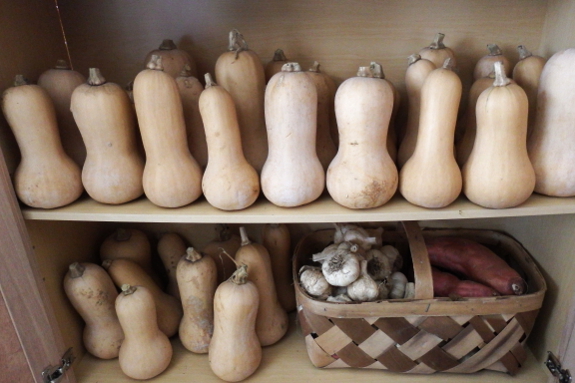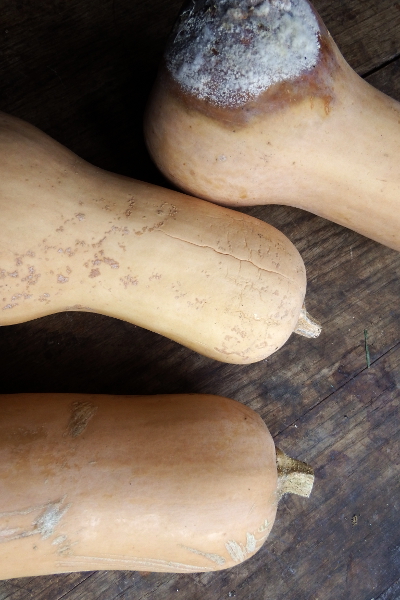
Rotating the butternuts

If you grow a year's supply of storage vegetables --- potatoes, winter squash, carrots, and so forth --- your job isn't done when you haul them out of the ground, cure them properly, then pack them away under just the right temperature and humidity conditions.
Instead, around midwinter, you've got one task left --- checking
through your stores to make sure one bad apple doesn't spoil the barrel.
Even though the task is
important, though, I don't mark storage-vegetable rotation time on my
calendar. Instead, I just keep an eye out during harvest until I notice
the first sign of spoilage. At that point, I go through the lot, pulling
out fruits and roots that aren't quite 100%. Now that we have goats,
those troubled vegetables are earmarked to turn into animal fodder ASAP,
but in previous years I've relegated them to human soups.
 Either way, while you're poking through your stores, you might also decide to change the vegetables' location too. Our butternut closet
did an awesome job in the fall and early winter. But now that serious
cold weather is hitting, the closet is really a little too cold for
optimal "warm vegetable" storage. So I moved the butternuts into our new cabinet
in the kitchen and filled the closet up with the containers that
recently held frozen food. Come summer, those containers will go back
into the freezer, leaving the closet space free for the next round of
butternuts.
Either way, while you're poking through your stores, you might also decide to change the vegetables' location too. Our butternut closet
did an awesome job in the fall and early winter. But now that serious
cold weather is hitting, the closet is really a little too cold for
optimal "warm vegetable" storage. So I moved the butternuts into our new cabinet
in the kitchen and filled the closet up with the containers that
recently held frozen food. Come summer, those containers will go back
into the freezer, leaving the closet space free for the next round of
butternuts.
I'll end with an
obsessive Anna-count of our butternut stores. We started out the season
with about 100 of them, and we certainly haven't been sparing in the
interim. I think I've given away about a dozen, the goats have gorged,
and we've eaten some too. (Although the warm fall means we haven't
actually put many butternuts in our belly --- brussels sprouts and kale
and lettuce just seemed more tasty at the time.)
Now that we've passed the inflection point
and are heading into spring, how many squash are left? The photo above
shows how I made my decisions --- only the bottom butternut passed the
test since wrinkled skin is enough to put a squash in the goat category
in my book. Using that measurement of quality, we ended up with 50 prime
specimens plus another 10 that need to be fed to the goats in the next
week or two. Not bad! Looks like we should grow about the same number
next year, assuming Mom and Artemesia maintain their taste for the rich,
orange flesh.
Want more in-depth information? Browse through our books.
Or explore more posts by date or by subject.
About us: Anna Hess and Mark Hamilton spent over a decade living self-sufficiently in the mountains of Virginia before moving north to start over from scratch in the foothills of Ohio. They've experimented with permaculture, no-till gardening, trailersteading, home-based microbusinesses and much more, writing about their adventures in both blogs and books.
Want to be notified when new comments are posted on this page? Click on the RSS button after you add a comment to subscribe to the comment feed, or simply check the box beside "email replies to me" while writing your comment.
